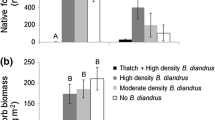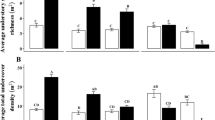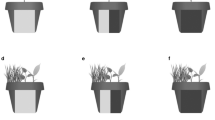Abstract
Whether facilitation from native plants is strong enough to trigger community dominance by non-natives remains unclear. We explored the possibility that facilitation from Prosopis caldenia, the dominant native tree in the semiarid open forest of central Argentina, drives local community dominance by Chenopodium album, an annual herb native to Europe. We assessed this hypothesis by conducting extensive field sampling in which we recorded the relative abundance of species growing under the canopy of P. caldenia (caldén microsites) and in adjacent locations free of this tree (open microsites). If our hypothesis is correct, then the relative abundance of C. album will be greater than that of the rest of the species only when growing under P. caldenia. Also, we measured C. album performance, estimated its soil seed bank, and characterized growing conditions in caldén and open microsites. We found that the relative abundance of C. album was over seven times greater than that of any other species in communities occurring in caldén microsites; by contrast, C. album co-dominated communities with several other species in the open. Chenopodium album density, cover, biomass, and fecundity were all several times greater in caldén than open microsites. Similarly, C. album seed bank displayed an eight-fold increase in caldén as compared to open microsites. Growing conditions were markedly different between microsites, which could explain positive responses from C. album. Our results suggest that facilitation from natives is indeed strong enough to trigger local community dominance by non-natives, advancing the understanding of community-level consequences of this interaction.





Similar content being viewed by others
Data availability
The datasets generated and/or analyzed during the current study will be available in the dryad repository upon the acceptance of this manuscript.
References
Abatzoglou JT, Kolden CA (2011) Climate change in western US deserts: potential for increased wildfire and invasive annual grasses. Range Ecol Manag 64:471–478
Abella SR, Chiquione LP (2018) The good with the bad: when ecological restoration facilitates native and non-native species. Res Ecol 27:343–351
Adler PB, HilleRisLambers J, Levine JM (2007) A niche for neutrality. Ecol Lett 10:95–104
Alba C, Skalova H, McGregor KF, D’Antonio C, Pysek P (2015) Native and exotic plant species respond differently to wildfire and prescribed fire as revealed by meta-analysis. J Veg Sci 26:102–113
Archer S, Predick KI (2008) Climate change and ecosystems of the Southwestern United States. Rangelands 6:23–28
Badano EI, Villarroel E, Bustamante RO, Marquet PA, Cavieres LA (2007) Ecosystem engineering facilitates invasions by exotic plants in high-Andean ecosystems. J Ecol 95:682–688
Badano EI, Bustamante RO, Villarroel E, Marquet PA, Cavieres LA (2015) Facilitation by nurse plants regulates community invasibility in harsh environments. J Veg Sci 26:756–767
Benet-Pierce N, Simpson MG (2014) The taxonomy of Chenopodium dessicatum and C. nitens, sp. Nov J Torrey Bot Soc 1411:161–172
Bertness MD, Callaway RM (1994) Positive interactions in communities. Trends Ecol Evol 9:191–193
Bolker BM, Brooks ME, Clark CJ et al (2009) Generalized linear mixed models: a practical guide for ecology and evolution. Trends Ecol Evol 24:127–135
Bruno JF, Stachowicz JJ, Bertness M (2003) Inclusion of facilitation into ecological theory. Trends Ecol Evol 18:119–125
Bulleri F, Benedetti-Cecchi L (2008) Facilitation of the introduced green alga Caulerpa racemosa by resident algal turfs: experimental evaluation of underlying mechanisms. Mar Eol Progr Ser 364:77–86
Bulleri F, Bruni JF, Benedetti-Cecchi L (2008) Beyond competition: incorporating positive interactions between species to predict ecosystem invasibility. PLoS Biol 6:1136–1140
Bulleri F, Tamburello L, Benedetti-Cecchi L (2009) Loss of consumers alters the effects of resident assemblages on the local spread of an introduced macroalga. Oikos 118:269–279
Bulleri F, Bruno JF, Silliman BR, Stachowicz, (2016) Facilitation and the niche: implications for coexistence, range shifts and ecosystem functioning. Funct Ecol 30:70–78
Cabrera AL (1994) Regiones fitogeográficas argentinas, Primera, re. Acme, Buenos Aires
Callaway RM, Nadkarni N, Mahall BE (1991) Facilitation and interference of Quercus douglasii on understory productivity in central California. Ecology 72:1484–2149
Callaway RM, Kikvidze Z, Kikodze D (2000) Facilitation by unpalatable weed may conserve plant diversity in overgrazed meadows in the Caucasus Mountains. Oikos 89:275–282
Callaway RM, Kikodze D, Chiboshvili M et al (2005) Unpalatable plants protect neighbors from grazing and increase plant community diversity. Ecology 86:1856–1862
Campos CM, Campos VE, Mongeaud A, Borghi CE, De los Ríos C, Gianonni SM, (2011) Relationships between Prosopis flexuosa (Fabaceae) and cattle in the Monte desert: Seeds, seedlings and saplings on cattle-use site classes. Rev Chil Hist Nat 84:289–299
Cano E, Fernandez B, Montes M (1980) Inventario Integrado de los Recursos Naturales de la Provincia de La Pampa. Clima, Geomorfología, Suelo y Vegetación (in Spanish)
Cavieres LA, Badano EI (2009) Do facilitative interactions increase species richness at the entire community level? J Ecol 97:1181–1191
Cavieres LA, Quiroz CL, Molina-Montenegro MA, Muñoz AA, Pauchard A (2005) Nurse effect of the native cushion plant Azorella monantha on the invasive non-native Taraxacum officinale in the high-Andes of central Chile. Pers Plant Ecol Evol Syst 7:217–226
Cavieres LA, Badano EI, Sierra-Almeida A, Molina-Montenegro MA (2007) Microclimatic modifications of cushion plants and their consequences for seedling survival of native and non-native herbaceous species in the high Andes of central Chile. Arc Ant Alp Res 39:229–236
Cavieres LA, Quiroz CL, Molina-Montenegro MA (2008) Facilitation of the non-native Taraxacum officinale by native nurse cushion species in the high Andes of central hile: are there differences between nurses? Funct Ecol 22:148–156
Cavieres LA, Brooker RW, Butterfield BJ et al (2014) Facilitative plant interactions and climate simultaneously drive alpine plant diversity. Ecol Lett 17:193–202
Caviglia JA, Lorda HO, Lemes JD (2010) Caracterización de las unidades de producción agropecuarias en la provincia de La Pampa, vol. 99 Ediciones INTA (in Spanish)
Chesson P (2000) Mechanisms of maintenance of species diversity. Annu Rev Ecol Syst 31:343–366
Chiuffo MC, MacDougall A, Hierro JL (2015) Native and nonnative ruderals experience similar plant–soil feedbacks and neighbor effects in a system where they coexist. Oecologia 179:843–852
Chiuffo MC, Cock MC, Prina AO, Hierro JL (2018) Response of native and nonnative ruderals to natural and human disturbance. Biol Invasions 20:2915–2925
Cock MC, Hierro JL (2020a) Native weed protects species that sustain cattle raising in semi-arid natural grasslands. J Arid Environ 175:104088
Cock MC, Hierro JL (2020b) Plant interactions balance under biotic and abiotic stressors: the importance of herbivory in semi-arid ecosystems. Oecologia 194:685–694
Collins M, Knutti R, Arblaster J et al (2013) Long-term climate change: projections, commitments and irreversibility. In: Stocker TF, Qin D, Plattner G-K, et al (eds), Climate change 2013—the physical science basis: contribution of working group I to the fifth assessment report of the intergovernmental panel on climate change pp 1029–1136. (Intergovernmental Panel on Climate Change). Cambridge University Press
Cushman JH, Lortie CJ, Christian CE (2011) Native herbivores and plant facilitation mediate the performance and distribution of an invasive exotic grass. J Ecol 99:524–531
D’Antonio CM, Dudley TL, Mack M (1999) Disturbance and biological invasions: direct effects and feedbacks. In: Walker LR (ed) Ecosystems of disturbed ground. Elsevier, Amsterdam, pp 413–452
Ernst RD, Morici E, Estelrich HD, Muiño WA, Ruiz MA (2015) Efecto de la quema controlada sobre el banco de semillas de gramíneas en diferentes parches del bosque de caldén en la región semiárida central Argentina. Arch Zootec 64:245–254 ((in Spanish))
Fernández OA, Leguizamón ES, Acciaresi HA, Troiani HO, Villamil CB (2016) Malezas e invasoras de la Argentina. Tomo II: descripción y reconocimiento, 1st edn. Universidad Nacional del Sur, Bahía Blanca (in Spanish)
Gallien L, Carboni M (2017) The community ecology of invasive species: where are we and what’s next? Ecography 40:335–352
Gioria M, Pysek P (2016) The legacy of plant invasions: changes in the soil seed bank of invaded plant communities. Bioscience 66:40–53
Gómez Aparicio L, Gómez JM, Zamora R, Boettinger JL (2005) Canopy versus soil effects of shrubs facilitating tree seedlings in Mediterranean montane ecosystems. J Veg Sci 16:191–198
Griffith AB (2010) Positive effects of native shrubs on Bromus tectorum demography. Ecology 91:141–154
Groom MJ, Meffe GK, Carroll CR (2006) Principles of conservation biology. Sinauer Associates, Sunderland
Gurevitch J, Scheiner SM, Fox GA (2020) The ecology of plants, 3rd edn. Sinauer Associates, Sunderland
He Q, Bertness MD, Altieri AH (2013) Global shifts towards positive species interactions with increasing environmental stress. Ecol Lett 16:695–706
Hierro JL, Cock MC (2013) Herbivore-mediated facilitation alters composition and increases richness and diversity in ruderal communities. Plant Ecol 214:1287–1297
Hierro JL, Villarreal D, Eren Ö, Graham J, Callaway RM (2006) Disturbance facilitates invasions: the effects are stronger abroad than at home. Am Nat 168:144–156
Hierro JL, Lortie CJ, Villarreal D, Estanga-Mollica ME, Callaway RM (2011) Resistance to Centaurea solstitialis from annual and perennial grasses in California and Argentina. Biol Invasions 13:2249–2259
Hierro JL, Khetsuriani L, Andonian K, Eren Ö, Villarreal D, Janoian G, Callaway RM (2017) The importance of factors controlling species abundance and distribution varies in native and non-native ranges. Ecography 40:991–1002
HilleRisLambers J, Adler PB, Harpole WS, Levine JM, Mayfield MM (2012) Rethinking community assembly through the lens of coexistence theory. Annu Rev Ecol Evol Syst 43:227–248
Huang F, Lankau R, Peng S (2018) Coexistence via coevolution driven by reduced allelochemical effects and increased tolerance to competition between invasive and native plants. New Phytol 218:357–369
Hunter AF, Aarssen LW (1988) Plants helping plants. Bioscience 38:34–40
Hupp N, Llambi LD, Ramírez L, Callaway RM (2017) Alpine cushion plants have species-specific effects on microhabitat and community structure in the tropical Andes. J Veg Sci 28:928–938
Iponga DM, Milton SJ, Richardson DM (2009) Soil type, microsite, and herbivory influence growth and survival of Schinus molje (Peruvian pepper tree) invading semi-arid African savanna. Biol Invasions 11:159–169
Jauni M, Gripenberg S, Ramula S (2015) Non-native plant species benefit from disturbance: a meta-analysis. Oikos 124:122–129
Jeschke JM, Gómez Aparicio L, Haider S, Heger T, Lortie CJ, Pysek P, Strayer D (2012) Support for major hypotheses in invasion biology is uneven and declining. NeoBiota 14:1–20
Keane RM, Crawley MJ (2002) Exotic plant invasions and the enemy release hypothesis. Trends Ecol Evol 17:164–170
Klironomos JK (2002) Feedback with soil biota contributes to plant rarity and invasiveness in communities. Nature 417:67–70
Kuebbing SE, Nuñez MA (2016) Invasive non-native plants have a greater effect on neighboring natives than other non-natives. Nature Plants 1–7
Lenz TI, Facelli JM (2003) Shade facilitates an invasive stem succulent in a chenopod shrubland in South Australia. Austral Ecol 28:480–490
Llorens EM (2013) Caracterización y manejo de los pastizales del centro de La Pampa. Ministerio de la Producción, Gobierno de La Pampa, p 52
Lortie CJ, Brooker RW, Choler P, Kikvidze Z, Michalet R, Pugnaire FI, Callaway RM (2004) Rethinking plant community theory. Oikos 107:433–438
Lozano YM, Hortal S, Armas C, Pugnaire FI (2020) Complementarity in nurse plant systems: soil drives community composition while microclimate enhances productivity and diversity. Plant Soil 450:385–396
Lucero JE, Noble T, Haas S, Westphal M, Butterfield HS, Lortie CJ (2019) The dark side of facilitation: native shrubs facilitate exotic annuals more strongly than native annuals. NeoBiota 44:75–93
Lucero JE, Seifan M, Callaway RM, Lortie CJ (2020) Positive associations with native shrubs are intense and important for an exotic invader but not the native annual community across an aridity gradient. Div Distr. https://doi.org/10.1111/ddi.13111
MacDougall AS, Gilbert B, Levine JM (2009) Plant invasions and the niche. J Ecol 97:609–615
MacDougall AS, Rillig MC, Klironomos JN (2011) Weak conspecific feedbacks and exotic dominance in a species-rich savanna. Proc R Soc B 278:2939–2945
Magurran AE, Hendriks PA (2003) Explaining the excess of rare species in natural species abundance distributions. Nature 422:714–716
Maron JL, Connors PG (1996) A native nitrogen-fixing shrub facilitates weed invasion. Oecologia 105:302–312
Maron JL, Pearson DE, Potter T, Ortega YK (2012) Seed size and provenance mediate the joint effects of disturbance and seed predation on community assembly. J Ecol 100:1492–1500
Mazzolari AC, Hierro JL, Vázquez DP (2020) Analysis of an invasion in the community context: differences and similarities between native and non-native shrubs. Plant Ecol 221:83–89
McIntire EJB, Fajardo A (2014) Facilitation as a ubiquitous driver of biodiversity. New Phytol 201:403–416
Moles AT et al (2012) Invasions: the trail behind, the path ahead, and a test of a disturbing idea. J Ecol 100:116–127
Morici E, Ernst T, Kin AG, Estelrich D, Mazzola M, Poey S (2003) Efecto del pastoreo en un pastizal semiárido de Argentina según la distancia a la aguada. Arch Zootec 52:59–66 ((in Spanish))
Morici E, Doménech García V, Gómez Castro G, Kin AG, Saenz AM, Rabotnikof CM (2009) Diferencias estructurales entre parches de pastizal del caldenal y su influencia sobre el banco de semillas, en la provincia de La Pampa, Argentina. Agrociencia 43:529–537 ((in Spanish))
Navie SC, Panetta FD, McFadyen RE, Adkins SW (2004) Germinable soil seedbanks of central Queensland rangelands invaded by the exotic weed Parthenium hysterophorus L. Weed Biol Manag 4:154–167
Norris S (2003) Neutral theory: a new, unified model for ecology. Bioscience 53:124–129
Oyarzabal et al (2018) Unidades de vegetación de la Argentina. Ecol Aus 28:40–63 ((in Spanish))
Pearson DE, Hierro JL, Chiuffo MC, Villarreal D (2014a) Rodent seed predation as a biotic filter influencing exotic plant abundance and distribution. Biol Invasions 16:1185–1196
Pearson DE, Ortega YK, Eren Ö, Hierro JL (2018a) Community assembly theory as a conceptual framework for invasions. Trends Ecol Evol 33:313–325
Pearson DE, Ortega YK, Villarreal D et al (2018b) The fluctuating resource hypothesis explains vulnerability, but not exotic advantage following disturbance. Ecology 99:1296–1305
Perkins LB, Nowak RS (2013) Native and non-native grasses generate common types of plant–soil feedbacks by altering soil nutrients and microbial communities. Oikos 122:199–208
Preston FW (1948) The commonness, and rarity, of species. Ecology 29:254–283
Ramírez L, Rada F, Llambí LD (2015) Linking patterns and processes through ecosystem engineering: effects of shrubs on microhabitat and water status of associated plants in the high tropical Andes. Plant Ecol 216:213–225
Rebollo S, Milchunas DG, Noy-Meir I et al (2002) The role of a spiny plant refuge in structuring grazed short grass steppe plant communities. Oikos 98:53–64
Reisner MD, Doescher PS, Pyke DA (2015) Stress-gradient hypothesis explains susceptibility to Bromus tectorum invasion and community stability in North America’s semi-arid Artemisia tridentata wyomingensis ecosystems. J Veg Sci 26:1212–1224
Richardson DM, Allsopp N, D’Antonio CM, Milton SJ, Rejmánek M (2000) Plant invasions—the role of mutualisms. Biol Rev 75:65–93
Roche MD, Pearse IS et al (2021) Negative effects of an allelopathic invader on AM fungal plant species drive community-level responses. Ecology 102:e03201
Salomone F (2005) Desarrollo de un índice de abundancia relativa para ciervo colorado (Cervus elaphus) en la reserva provincial Parque Luro. La Pampa. Informe final, Consejo Federal de Inversiones Provincia de La Pampa ((in Spanish))
Sax DF, Brown JH (2000) The paradox of invasion. Global Ecol Biogeogr 9:363–371
Schlesinger WH, Raikes JA, Hartley AE, Cross AF (1996) On the spatial pattern of soil nutrients in desert ecosystems. Ecology 77:364–374
Shannon CE (1948) A mathematical theory of communication. Bell Syst Tech J 27:623–656
Shea K, Chesson P (2002) Community ecology theory as a framework for biological invasions. Trends Ecol Evol 17:170–176
Simberloff D (2006) Invasional meltdown 6 years later: Important phenomenon, unfortunate metaphor, or both? Ecol Lett 9:912–919
Simberloff D, Von Holle B (1999) Positive interactions of nonindigenous species: invasional meltdown. Biol Invasions 1:21–32
Travaset A, Richardson DM (2014) Mutualistic interactions and biological invasions. Ann Rev Ecol Evol Syst 45:89–113
Valiente-Banuet A, Vital Rumebe A, Verdú M, Callaway RM (2006) Modern quaternary plant linages promote diversity through facilitation of ancient Tertiary lineages. Proc Natl Acad Sci USA 103:16812–16817
van Kleunen M, Weber E, Fischer M (2010) A meta-analysis of trait differences between invasive and non-invasive plant species. Ecol Lett 13:235–245
West PW, Ramachandran TP (1966) Spectrophotometric determination of nitrate using chromotropic acid. Anal Chem Acta 35:317–324
Williams JT (1963) Biological flora of the British isles: Chenopodium album L. J Ecol 51:711–725
Yao S, Lan H, Zhang F (2010) Variation of seed heteromorphism in Chenopodium album and the effect of salinity stress on the descendants. Ann Bot 105:1015–1025
Acknowledgements
We recognize permission from ranch owners and Parque Luro authorities to conduct our work and logistical support from G. Rodríguez and D. Villarreal. We thank field and lab assistance of 24 undergraduate students, and are particularly in debt to M. Weinzettel, C. Polanco, R. Barón, P. Parache, E. Riesco, and M. García. Comments from two anonymous Reviewers greatly improved a previous version of this manuscript. This research was funded by the Agencia Nacional de Promoción Científica y Tecnológica, Argentina (PICT PIDRI 2007 0287) and UNLPam (RN27).
Author information
Authors and Affiliations
Corresponding author
Ethics declarations
Conflicts of interest
The authors have no conflicts of interest to declare that are relevant to the content of this article.
Additional information
Publisher's Note
Springer Nature remains neutral with regard to jurisdictional claims in published maps and institutional affiliations.
Supplementary Information
Below is the link to the electronic supplementary material.
Rights and permissions
About this article
Cite this article
Estanga-Mollica, M.E., Schmidt, R.M., Cock, M.C. et al. Non-native weed reaches community dominance under the canopy of dominant native tree. Biol Invasions 23, 2849–2861 (2021). https://doi.org/10.1007/s10530-021-02538-z
Received:
Accepted:
Published:
Issue Date:
DOI: https://doi.org/10.1007/s10530-021-02538-z




